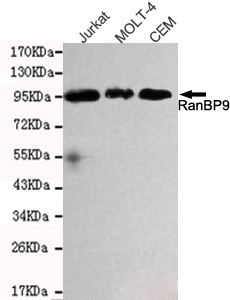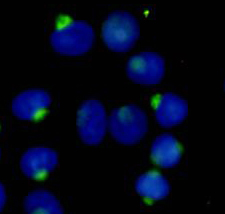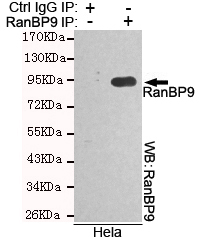- Home
- About
- Promotions
-
Products
-
Elisa Kits
- |
-
Primary antibodies
- |
-
Secondary antibodies
- |
-
Proteins
- |
-
IHC reagents
- |
-
WB reagents
- PonceauS Staining Solution
- PBST Washing Buffer, 10X
- 1.5M Tris-HCl Buffer, pH8.8
- 1M Tris-HCl Buffer, pH6.8
- 10% SDS Solution
- Prestained Protein Marker
- TBST Washing Buffer, 10X
- SDS PAGE Loading Buffer, 5X
- Stripping Buffered Solution
- Tris Buffer, pH7.4, 10X
- Total Protein Extraction Kit
- Running Buffer, 10X
- Transfer Buffer, 10X
- 30% Acr-Bis(29:1) Solution
- Tris电泳液速溶颗粒
- PBS(1X, premixed powder)
- TBS(1X, premixed powder)
- 快速封闭液
- 转膜液速溶颗粒
- Chemical reagents
- News
- Distributor
- Resources
- Contact
- Home
- >
- Info
- >
- RanBP9 mouse mAb
- >
- Go Back
RanBP9 mouse mAb
- Catalog No.:YM1304
- Applications:WB;ICC;IP
- Reactivity:Human
- Immunogen:
- Purified recombinant human RanBP9 protein fragments expressed in E.coli.
- Specificity:
- This antibody detects endogenous levels of RanBP9 and does not cross-react with related proteins.
- Formulation:
- Liquid in PBS containing 50% glycerol, 0.5% BSA and 0.02% sodium azide.
- Source:
- Monoclonal, Mouse
- Dilution:
- wb 1:1000 icc 1:300
- Purification:
- The antibody was affinity-purified from mouse ascites by affinity-chromatography using epitope-specific immunogen.
- Storage Stability:
- -15°C to -25°C/1 year(Do not lower than -25°C)
- Other Name:
- B cell antigen receptor Ig beta associated protein 1;BPM 90;BPM L;BPM-L;BPM90;BPML;IBAP 1;Imp 9;Importin 9;Novel centrosomal protein RanBPM;RAN binding protein 9;Ran binding protein centrosomal;Ran Binding Protein in the Microtubule organizing center;Ran binding protein M;Ran BP9;Ran-binding protein 9;Ran-binding protein M;RANB9_HUMAN;RanBP 7;RANBP 9;RanBP7;RanBP9;RanBPM.
- Background:
- This gene encodes a protein that binds RAN, a small GTP binding protein belonging to the RAS superfamily that is essential for the translocation of RNA and proteins through the nuclear pore complex. The protein encoded by this gene has also been shown to interact with several other proteins, including met proto-oncogene, homeodomain interacting protein kinase 2, androgen receptor, and cyclin-dependent kinase 11. [provided by RefSeq, Jul 2008],
- Function:
- caution:According to some authors (PubMed:9817760) RANBP9 would be located in centrosomes and involved in microtubule assembly, but other authors infirmed these results in (PubMed:11470507).,domain:The SPRY domain mediates the interaction with MET, AR, and CDC2L1.,function:May act as an adapter protein to couple membrane receptors to intracellular signaling pathways. May be involved in signaling of ITGB2/LFA-1 and other integrins. Enhances HGF-MET signaling by recruiting Sos and activating the Ras pathway. Involved in activation of androgen and glucocorticoid receptor in the presence of their cognate hormones. Stabilizes TP73 isoform Alpha, probably by inhibiting its ubiquitination, and increases its proapoptotic activity. Inhibits the kinase activity of DYRK1A and DYRK1B. Inhibits FMR1 binding to RNA.,PTM:Phosphorylated upon DNA damage, probably by ATM or ATR. Phosphorylated in response
- Subcellular Location:
- Cytoplasm . Nucleus . Cell membrane ; Peripheral membrane protein . The unphosphorylated form is predominantly cytoplasmic. A phosphorylated form is associated with the plasma membrane. .
- Expression:
- Ubiquitously expressed, with highest levels in testes, placenta, heart, and muscle, and lowest levels in lung. Within the brain, expressed predominantly by neurons in the gray matter of cortex, the granular layer of cerebellum and the Purkinje cells.

- Western blot detection of RanBP9 in Jurkat,MOLT-4 and CEM cell lysates and using RanBP9 mouse mAb (1:1000 diluted).Predicted band size: 78KDa.Observed band size: 95KDa.

- Immunocytochemistry stain of Hela using RanBP9 mouse mAb (1:300).

- Immunoprecipitation analysis of Hela cell lysates using RanBP9 mouse mAb.






